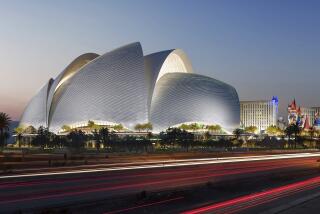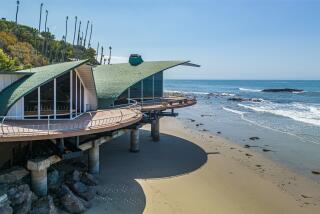Destination : Australia : At 20, Sydney Opera House Flies High
SYDNEY — The Sydney Opera House. That soaring, white-winged palace of the arts, which has been likened to everything from nun’s caps to sails to sections of an orange, is 20 years old.
The gleaming shells, jutting out of sparkling-blue Sydney Harbour, are recognized around the world. More than 36 million people have visited since its opening.
Some of the international artists who have performed in the more than 53,000 events staged include Joan Sutherland, Luciano Pavarotti, Marilyn Horne, Jessye Norman, Kiri Te Kanawa, Peter Allen, Bob Hope and Ella Fitzgerald.
The story of the building of the opera house starts with an English conductor of Belgian descent, Eugene Goossens, who was amazed when he came to Sydney in 1947 that the city didn’t have a first-class opera house. (He conducted his opera, “Judith,” with a young stenographer, Joan Sutherland, at the New South Wales Conservatorium of Music.)
Goossens began lobbying for a proper hall, and he won over the New South Wales government in 1954.
An advisory committee chose Bennelong Point, a tram turnaround that jutted out into Sydney Harbor and overlooked the famous Harbor Bridge, as the site. In August, 1955, a competition for the design was launched. Danish architect Jorn Utzon beat out 232 other contenders.
The dashing young Dane won on the strength of rough designs, not detailed plans. It was estimated to take three years and cost $7 million. Engineering hurdles proved enormously difficult, however; roof vaults of this size and curvature had never been built before.
Years passed while mathematicians, engineers and architects scratched their heads, drew and redrew, the public got bored, and the project became a political issue.
A new conservative government was voted in, vowing to get the job done. Architect Utzon resigned when his ideas didn’t mesh with the new administration’s. Others completed the project, which in the end took 14 years and cost $103 million.
Utzon has never returned to Australia to see the finished project, although a tour guide said there were reports that he showed up, disguised, in a tour.
In a recent newspaper interview with him at his home in Spain, Utzon said that the roofs were not modeled after the sails of yachts in the harbor, as many have thought, but after segments of an orange.
The money to finance the building was provided by the public, first through the Sydney Opera House Appeal Fund, to which hostesses, children, businessmen and arts lovers contributed.
When that fell short, the Opera House Lottery was created. Tickets were $6 each and people rushed to buy them. By July, 1975, 22 months after it opened, the opera house was paid for.
Today, the opera house is a central part of Sydney life. During intermissions, audiences from three different shows often mingle outside while enjoying the view. People can also listen to free concerts on the wide horizontal steps (designed after Mayan temples), grab a bite in one of two restaurants, take in a film, art exhibit, jazz performance or lecture.
The opera house contains a concert hall, an opera theater, a drama theater, two additional small theaters and an exhibition hall--5,200 seats in all. The complex, said to be the busiest in the world, houses the Sydney Theatre Co., the Sydney Dance Co., the Australian Ballet and the Australian Opera.
But with all the attention given to the external design, the interior spaces got short shrift and turned out smaller than performers would have wished. With the two main music theaters side by side, wing space is skimpy, requiring creative handling of sets. Also, performers don’t relish the long trek to their dressing rooms.
No microphones are used in the music theaters, which were supposedly designed with acoustics in mind.
Conductor John Hopkins, who was director of the Australian Broadcasting Co. at the time of the opening and later director of the New South Wales Conservatorium of Music, says the sound there is “rather lean.” But, he adds, “it’s easy to perform in. Artists have said it’s the aura of the place, there’s a tremendous feeling about being there.”
More to Read
Sign up for The Wild
We’ll help you find the best places to hike, bike and run, as well as the perfect silent spots for meditation and yoga.
You may occasionally receive promotional content from the Los Angeles Times.






